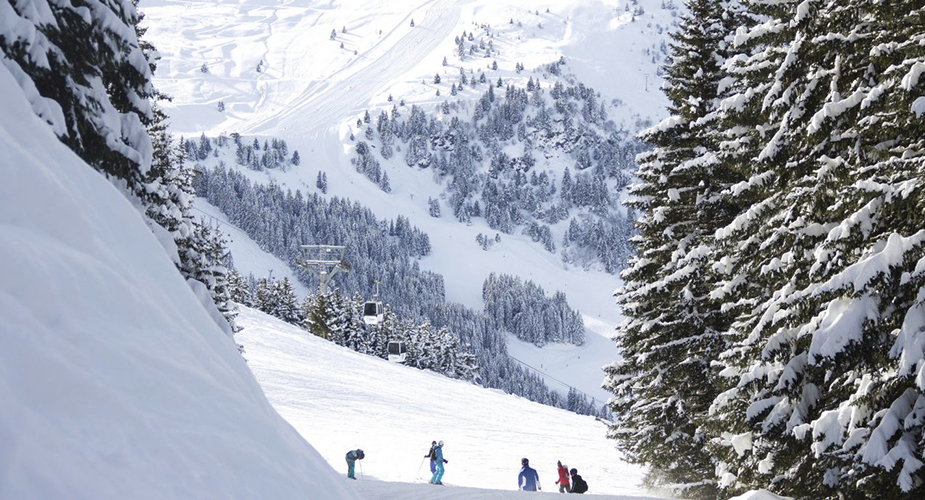With just two months to go in the winter season, lodging at mountain destinations continued to claw back some seasonal ground as declining COVID-19 cases and rapidly accelerating vaccination efforts encouraged short-term bookings for the remaining weeks of the ski and snowboard season, according to the most recent Mountain Market Briefing distributed by DestiMetrics.
Although much of the season has been a struggle for lodging properties in eight western states and across 18 mountain destinations, bookings made in February for arrivals in March set an all-time record. While the late-season burst is providing a welcome boost to properties, winter results are likely to fall short of the 2019/20 season that was abruptly cut short by the pandemic and well below the last full winter season of Winter 2018/19. The aggregated results include data on occupancy, daily rates, and revenues through February 28.
Booking Pace During February
Short-term and last-minute bookings in February had a dramatic impact on February and March arrivals as travelers responded positively to news about declining COVID-19 cases and aggressive vaccination programs. In a year-over-year comparison, bookings made in February for arrival within the month were up 129.4 percent while bookings for arrivals in March were up 31.7 percent and April up 15.1 percent. Though the trend is optimistic trend for May and June arrivals, analysts expect those to turn around in the coming weeks as consumers shift their vacation planning away from the waning winter season. Overall, February bookings for arrivals for the full six months from February through July are up an aggregated 50.2 percent compared to February 2020 when growing awareness and concern about COVID-19 was beginning to increase.
February Results
In a year-over-year comparison, actual occupancy for the month was down 18.1 percent and the Average Daily Rate (ADR) was down 8.9 percent. The decline in occupancy delivered a 25.4 percent decrease in revenues for the month. Despite the decreases, they were appreciably “less down” than they were in January, marking the continued gradual comeback for participating properties.
How The Full Winter Is Progressing
Aggregated occupancy for the full six-month season from November through April is down 21 percent compared to last year at this time but once again marks a significant improvement from last month when the season was down 33.1 percent. ADR is down 5.6 percent compared to last year at this time with gains in three of the six months led by April up 40.3 percent and November up 22.3 percent. However, the seasonally low occupancy and overall rates led to a 25.3 percent decline in revenues for the winter. Again, the decline still represents a notable month-over-month improvement when compared to January when revenues were down 32.3 percent.
A compelling note in the monthly Briefing observed that booking patterns were closely tied to first-time vaccination rates indicating consumer’s willingness to book destination travel as the pandemic anxiety is moderating with an increasingly vaccinated population.
“Although year-over-year occupancy, rates and revenue remain down sharply compared to last winter, the dramatic decline in COVID-19 cases, hospitalizations, and deaths coupled with good snowfall in many regions helped to drive strong bookings and incremental fill during the past month,” reported Tom Foley, senior vice president for Business Operations and Analytics for Inntopia. “The increases are almost entirely due to short-lead bookings with visitors arriving less than 60 days after making their bookings. And, we also saw a decline in cancellations this February compared to last February.”
Economic Measurements
The Dow Jones Industrial Average (DJIA) rose 3.17 percent in February to reach its highest-ever monthly closing as markets reacted positively to declines in COVID-19 cases, deaths and hospitalization as well as positive news about vaccine distribution and economic stimulus legislation. It is 21.7 percent higher than it was at the end of February 2020, a gain attributed somewhat to sharp market declines at the end of February last year. However, the Briefing also reiterated its message that the since mid-summer 2020, over-sold markets continue to discount consumer and employment conditions and are creating some volatility. The Consumer Confidence Index (CCI) crept up a cautious 2.2 percent during February but at 91.3 points remains well below its most recent high of 101.4 in October and is dramatically lower than the 132.6 points just one year ago in February 2020. The national Unemployment Rate declined from 6.3 percent in January to 6.2 percent in February and was aided by the addition of 379,000 new jobs that exceeded analysts’ expectations. The vast majority of those positions were in the leisure and hospitality industry as restrictions continued to ease in those sectors.
“As western mountain resorts approach the finish line of the ‘20-‘21 ski season, it is with more opportunity than they have had for almost exactly a year,” continued Foley. “Record-setting bookings for March arrivals are following on the heels of overall positive momentum in February and that momentum is combining with a reduction in cancellation to move overall performance in a positive direction. “But economic conditions remain unstable for many consumers, there are concerns about the reality of strengthening coronavirus variants, and Spring Break travel coinciding with the easing of pandemic restrictions with only 10 percent of the population fully vaccinated, are all considerations that could imperil the continuing recovery,” he concluded.













